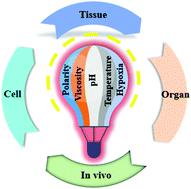当前位置:
X-MOL 学术
›
Chem. Soc. Rev.
›
论文详情
Our official English website, www.x-mol.net, welcomes your
feedback! (Note: you will need to create a separate account there.)
Small molecule based fluorescent chemosensors for imaging the microenvironment within specific cellular regions
Chemical Society Reviews ( IF 40.4 ) Pub Date : 2021-09-22 , DOI: 10.1039/d1cs00645b Junling Yin 1 , Ling Huang 2 , Luling Wu 3 , Jiangfeng Li 2 , Tony D James 3, 4 , Weiying Lin 2
Chemical Society Reviews ( IF 40.4 ) Pub Date : 2021-09-22 , DOI: 10.1039/d1cs00645b Junling Yin 1 , Ling Huang 2 , Luling Wu 3 , Jiangfeng Li 2 , Tony D James 3, 4 , Weiying Lin 2
Affiliation

|
The microenvironment (local environment), including viscosity, temperature, polarity, hypoxia, and acidic-basic status (pH), plays indispensable roles in cellular processes. Significantly, organelles require an appropriate microenvironment to perform their specific physiological functions, and disruption of the microenvironmental homeostasis could lead to malfunctions of organelles, resulting in disorder and disease development. Consequently, monitoring the microenvironment within specific organelles is vital to understand organelle-related physiopathology. Over the past few years, many fluorescent probes have been developed to help reveal variations in the microenvironment within specific cellular regions. Given that a comprehensive understanding of the microenvironment in a particular cellular region is of great significance for further exploration of life events, a thorough summary of this topic is urgently required. However, there has not been a comprehensive and critical review published recently on small-molecule fluorescent chemosensors for the cellular microenvironment. With this review, we summarize the recent progress since 2015 towards small-molecule based fluorescent probes for imaging the microenvironment within specific cellular regions, including the mitochondria, lysosomes, lipid drops, endoplasmic reticulum, golgi, nucleus, cytoplasmic matrix and cell membrane. Further classifications at the suborganelle level, according to detection of microenvironmental factors by probes, including polarity, viscosity, temperature, pH and hypoxia, are presented. Notably, in each category, design principles, chemical synthesis, recognition mechanism, fluorescent signals, and bio-imaging applications are summarized and compared. In addition, the limitations of the current microenvironment-sensitive probes are analyzed and the prospects for future developments are outlined. In a nutshell, this review comprehensively summarizes and highlights recent progress towards small molecule based fluorescent probes for sensing and imaging the microenvironment within specific cellular regions since 2015. We anticipate that this summary will facilitate a deeper understanding of the topic and encourage research directed towards the development of probes for the detection of cellular microenvironments.
中文翻译:

基于小分子的荧光化学传感器,用于对特定细胞区域内的微环境进行成像
微环境(局部环境),包括粘度、温度、极性、缺氧和酸碱状态 (pH),在细胞过程中起着不可或缺的作用。重要的是,细胞器需要适当的微环境来执行其特定的生理功能,而微环境稳态的破坏可能会导致细胞器发生故障,从而导致紊乱和疾病的发展。因此,监测特定细胞器内的微环境对于了解细胞器相关的病理生理学至关重要。在过去的几年里,已经开发了许多荧光探针来帮助揭示特定细胞区域内微环境的变化。鉴于全面了解特定细胞区域的微环境对于进一步探索生命事件具有重要意义,因此迫切需要对该主题进行全面总结。然而,最近还没有关于用于细胞微环境的小分子荧光化学传感器发表全面和批判性的评论。通过这篇综述,我们总结了自 2015 年以来在基于小分子的荧光探针对特定细胞区域(包括线粒体、溶酶体、脂滴、内质网、高尔基体、细胞核、细胞质基质和细胞膜)内的微环境进行成像方面取得的最新进展。在亚细胞器层面进一步分类,根据探针检测微环境因素,包括极性、粘度、温度、pH和缺氧,被提出。值得注意的是,在每个类别中,对设计原理、化学合成、识别机制、荧光信号和生物成像应用进行了总结和比较。此外,分析了当前微环境敏感探针的局限性,并概述了未来发展的前景。简而言之,这篇综述全面总结并强调了自 2015 年以来在基于小分子的荧光探针对特定细胞区域内的微环境进行传感和成像方面取得的最新进展。我们预计该总结将有助于更深入地了解该主题并鼓励针对开发用于检测细胞微环境的探针。荧光信号和生物成像应用进行了总结和比较。此外,分析了当前微环境敏感探针的局限性,并概述了未来发展的前景。简而言之,这篇综述全面总结并强调了自 2015 年以来在基于小分子的荧光探针对特定细胞区域内的微环境进行传感和成像方面取得的最新进展。我们预计该总结将有助于更深入地了解该主题并鼓励针对开发用于检测细胞微环境的探针。荧光信号和生物成像应用进行了总结和比较。此外,分析了当前微环境敏感探针的局限性,并概述了未来发展的前景。简而言之,这篇综述全面总结并强调了自 2015 年以来在基于小分子的荧光探针对特定细胞区域内的微环境进行传感和成像方面取得的最新进展。我们预计该总结将有助于更深入地了解该主题并鼓励针对开发用于检测细胞微环境的探针。分析了当前微环境敏感探针的局限性,并概述了未来发展的前景。简而言之,这篇综述全面总结并强调了自 2015 年以来在基于小分子的荧光探针对特定细胞区域内的微环境进行传感和成像方面取得的最新进展。我们预计该总结将有助于更深入地了解该主题并鼓励针对开发用于检测细胞微环境的探针。分析了当前微环境敏感探针的局限性,并概述了未来发展的前景。简而言之,这篇综述全面总结并强调了自 2015 年以来在基于小分子的荧光探针对特定细胞区域内的微环境进行传感和成像方面取得的最新进展。我们预计该总结将有助于更深入地了解该主题并鼓励针对开发用于检测细胞微环境的探针。
更新日期:2021-09-22
中文翻译:

基于小分子的荧光化学传感器,用于对特定细胞区域内的微环境进行成像
微环境(局部环境),包括粘度、温度、极性、缺氧和酸碱状态 (pH),在细胞过程中起着不可或缺的作用。重要的是,细胞器需要适当的微环境来执行其特定的生理功能,而微环境稳态的破坏可能会导致细胞器发生故障,从而导致紊乱和疾病的发展。因此,监测特定细胞器内的微环境对于了解细胞器相关的病理生理学至关重要。在过去的几年里,已经开发了许多荧光探针来帮助揭示特定细胞区域内微环境的变化。鉴于全面了解特定细胞区域的微环境对于进一步探索生命事件具有重要意义,因此迫切需要对该主题进行全面总结。然而,最近还没有关于用于细胞微环境的小分子荧光化学传感器发表全面和批判性的评论。通过这篇综述,我们总结了自 2015 年以来在基于小分子的荧光探针对特定细胞区域(包括线粒体、溶酶体、脂滴、内质网、高尔基体、细胞核、细胞质基质和细胞膜)内的微环境进行成像方面取得的最新进展。在亚细胞器层面进一步分类,根据探针检测微环境因素,包括极性、粘度、温度、pH和缺氧,被提出。值得注意的是,在每个类别中,对设计原理、化学合成、识别机制、荧光信号和生物成像应用进行了总结和比较。此外,分析了当前微环境敏感探针的局限性,并概述了未来发展的前景。简而言之,这篇综述全面总结并强调了自 2015 年以来在基于小分子的荧光探针对特定细胞区域内的微环境进行传感和成像方面取得的最新进展。我们预计该总结将有助于更深入地了解该主题并鼓励针对开发用于检测细胞微环境的探针。荧光信号和生物成像应用进行了总结和比较。此外,分析了当前微环境敏感探针的局限性,并概述了未来发展的前景。简而言之,这篇综述全面总结并强调了自 2015 年以来在基于小分子的荧光探针对特定细胞区域内的微环境进行传感和成像方面取得的最新进展。我们预计该总结将有助于更深入地了解该主题并鼓励针对开发用于检测细胞微环境的探针。荧光信号和生物成像应用进行了总结和比较。此外,分析了当前微环境敏感探针的局限性,并概述了未来发展的前景。简而言之,这篇综述全面总结并强调了自 2015 年以来在基于小分子的荧光探针对特定细胞区域内的微环境进行传感和成像方面取得的最新进展。我们预计该总结将有助于更深入地了解该主题并鼓励针对开发用于检测细胞微环境的探针。分析了当前微环境敏感探针的局限性,并概述了未来发展的前景。简而言之,这篇综述全面总结并强调了自 2015 年以来在基于小分子的荧光探针对特定细胞区域内的微环境进行传感和成像方面取得的最新进展。我们预计该总结将有助于更深入地了解该主题并鼓励针对开发用于检测细胞微环境的探针。分析了当前微环境敏感探针的局限性,并概述了未来发展的前景。简而言之,这篇综述全面总结并强调了自 2015 年以来在基于小分子的荧光探针对特定细胞区域内的微环境进行传感和成像方面取得的最新进展。我们预计该总结将有助于更深入地了解该主题并鼓励针对开发用于检测细胞微环境的探针。











































 京公网安备 11010802027423号
京公网安备 11010802027423号